
1961
History
of the Eloise Butler Wildflower Garden
and The Friends of the Wildflower Garden
Ken Avery begins his 3rd year as Gardener. Both Sam Baker and Ed Bruckelmyer helped Ken in the Garden this year. Howard Moore is the new Superintendent of Parks for the Board of Park Commissioners. Charles Doell had resigned in early 1960.

There was no snow cover through November and December of 1960 except for one inch measured during the last week of the year. This was not a good sign for next years plant growth and for winter protection. The first six weeks of 1961 were not much better. After mid-February there were two significant snow falls of 7 inches around the 17th and 6 inches around March 3rd. January had numerous days where the daily maximum temperature was above 40 degrees, but in February, things were not as warm as there were many days with sub-zero temperature minimums.
Editor Martha Crone, looking forward to spring, wrote in the winter issue of the Friend's newsletter, The Fringed Gentian™, (Vol. 9 No. 1) that:
Wearied by winter’s drab and somber tone, this weathered look is soon erased when the sun mounts in the sky and we are again safe through the winter storms. Any day now there will be a whisper of spring in the wind and another winter has blown itself out.
In the same issue she wrote about cold weather birds - Chickadees, Hairy and Downy Woodpeckers, Blue Jays and Cardinals. She discussed a wide variety of other topics: Cardamom seed, Zodiacal light, Wild Passion Flower, Peanuts, Cashews and the Grand Marais Garden Club’s new Wildflower Garden.
[Note: Late in the previous year Martha Crone received notice from Lucille Walker of the Grand Marais Garden Club that she had been elected an honorary member. The Garden Club had just established what they named “The Wild Flower Sanctuary” and Martha had given them some guidance in that endeavor.]
The annual meeting of The Friends of the Wild Flower Garden was held on January 10th, at the home of President Mrs. Carroll (Dorothy) Binder.
Elected to the Board of Directors were: Kenneth Avery, Russell H. Bennett, Betty Bridgman, Mrs. Bernard Bowron, Earle Brown, Dorothy W. Binder, Elizabeth Carpenter, Martha Crone, Marion Cross, Whitney Eastman, Lloyd Hale, Walter Lehnert, Alice Martin, Leonard Odell, Leonard F. Ramberg, Carl W. Rawson, Mrs. Robert Strange, Ebba Tolg.
New directors Mrs. Bridgman and Mr. Eastman would have a long history with the Friends Board.
At the Board Meeting following, Dorothy Binder was reelected President; Leonard F. Ramberg was elected Vice-President and Martha Crone was reelected Secretary/Treasurer and she continued as editor of The Fringed Gentian™ and as membership secretary.
It was voted to give $500 to the Board of Park Commissioners to assist in maintenance of the Wild Flower Garden, the same amount as in past years since the founding of the Friends in 1952.
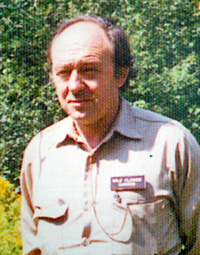
In the Garden, Gardener Ken Avery reports that the spring flowers were not at their best due to the very cold spring weather. He was referring to April when daily temperature maximums were usually below the averages for those days. There was even a 5 inch snowfall around April 15th. Even in May and June the daily minimum temperatures were below average many days.
It was however, a very good year for spring birding with an unusually large number of species being seen. Ken reported that:
“These birds are just as important to the Garden as are the flowers since at least as much interest is shown in them as in the flowers.”
He further noted in his annual report (1) that “In light of this, I have enrolled in a course in Minnesota Birds at the University of Minnesota to increase my competence in this field.”
In the spring issue (Vol. 9 No. 2) of The Fringed Gentian™, Martha Crone wrote about the Minnesota state bird - the common Loon and also about cliff swallows, home gardens and the hibernation of turtles. She also noted "The trees in May offer many lovely sights, but none finer than when in bloom, especially the wild cherries, plum and hawthorn's.”
This poem by L. H. Bailey was offered:
Yesterday the twig was brown and bare,
Today the glint of green is there
Tomorrow will be leaflets spare
I know no thing so wondrous fair
No miracle so strangely rare.
Spring did eventually arrive. The Friends of the Wild Flower Garden hosted an open house on May 20th and Ken Avery led a conducted tour of the Garden to great success. The Yellow Lady’s-slipper (Cypripedium parviflorum var. pubescens) was in bloom that day along with many other spring flowers.
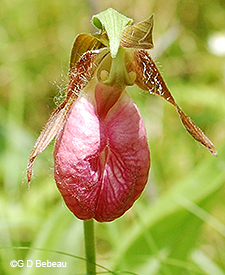
Summer was kind to the Garden again this year. There was adequate rainfall and temperatures were within the average range for the period with only a few days at the end of June when the temperature exceeded 90 degrees.
During the summer Ken Avery was at work re-digging the pools in the wetland area of the Woodland Garden. These were three pools of open water maintained in the wetland for the pleasant effect and as an environment for specific plants. In addition there was another larger pool at the back fence. They had silted in such that Ken reported one pool had a depth of only three inches.
[Note: The three small pools where originally dug out in 1946/1947 under the supervision of Curator Martha Crone, following the creation of a new trail through the wetland in 1946 - basically, the trail that exists today. She enlarged the pools in 1948. See the historic photos below and more detail in the History of the Wetland.]
Ken and assistant Ed Bruckelmyer (who retired in 1970) re-dug them to a depth of 18 inches. He also created a water channel between the three pools so that filling one pool would fill the others instead of having to fill each pool separately.(1) When rain was scarce, the pools could be filled with a hose lugged down the hill from the city water supply in the Upland Garden. Ken requested that the water lines be run down to the lower garden in his 1960 report to the Park Commissioners but it would be 1964 before approval came.
Below: Two photos from Kodachromes by Martha Crone of one of the small pools created in 1947 under her supervision.
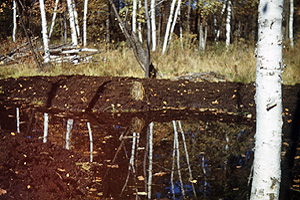
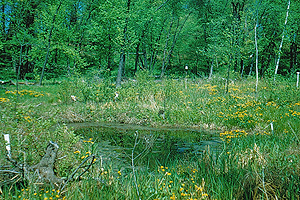
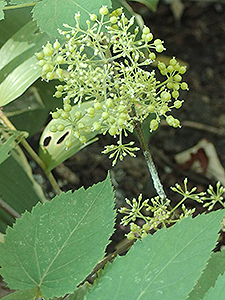
The other new addition to the Garden was the replacement of the pit toilets with chemical toilets. Back in 1956 Curator Martha Crone had requested replacements for the pits. She wrote in her annual report on Feb. 14, 1956:
The 'Comfort Station' facilities of the garden have been most deplorable for many years, becoming more so with the ever increasing attendance. The situation has been looked over and it is earnestly hoped that it will be improved this season. It obviously took longer.
Ken Avery ordered a number of plants from Orchid Gardens in Grand Rapids Minnesota. All are Minnesota native; all had been previously growing in the Garden, and all were included on Martha Crone’s 1951 census of plants in the Garden at that time, however, most are no longer extant in the Garden. Ken Avery’s terminology given first, then the more current terminology if any. These included:
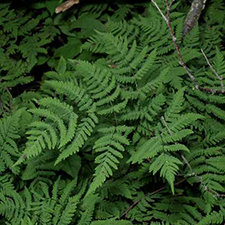
- Three-leaved Solomon’s Seal (Threeleaf False Lily of the Valley), (Smilacina trifolia - now classified as Maianthemum trifolium) Eloise Butler first noted this plant in the Garden in 1908. No longer extant.
- American Spikenard (Aralia racemosa). Replanted as recently as 2016.
- Threeleaf Goldthread (Coptis trifolia). Eloise Butler first planted this species in 1908 and noted the first blooms in 1910. No longer extant.
- Pink Moccasin Flower (Cypripedium acaule). Eloise Butler first planted this species in 1907, and in many subsequent years. Martha Crone first planted it in 1936. No longer extant. PHOTO ABOVE
- Fireweed (Epilobium angustifolium - now classified Chamerion angustifolium) Although a native plant to Minnesota, Eloise Butler's records show that she obtained plants of this species from Malden, Mass. on Sept. 4th, 1909. Martha Crone first planted it in 1933 and in 1934 transplanted specimens collected on Isle Royal. Today the plant is still well established in the Upland Garden along Goldenrod Trail.
- Twinflower (Linnaea americana - now classified as Linnaea borealis ssp. americana) This plant is becoming rare in a number of locales. It is on the “threatened" or "endangered" list or actually extirpated in a number of states east of the Mississippi River. Martha Crone planted it in the Garden, first in 1933 and in subsequent years. No longer extant.
- Monkey Flower (Allegheny monkeyflower or Square-stemmed Monkey Flower) (Mimulus ringens). Eloise Butler introduced this plant to the Garden in 1910 and noted the first bloom in 1911. Martha Crone planted it in 1933.
- Rattlesnake Fern (Virginia Grape fern) (Botrychium virginianum). Martha Crone first planted it in 1935 and 1936.
- Oakfern (Western Oakfern) (Dryopteris Linnaeana -now classified as Gymnocarpium dryopteris). Eloise Butler first planted this species in 1908 and 1909. Martha Crone first planted it in 1933. No longer extant.
- Yarrow (Achillea millefolium). Yarrow is indigenous to the Garden area. Eloise Butler catalogued it on May 25, 1907.
As an interesting aside - consider the prices paid in 1961: Most of these plants were $3.50 per dozen and the Three-leaved Solomon’s Seal of which Ken purchased 200, was 20 cents each.
In the summer issue of the Friend's Newsletter, (Vol. 9 No. 3) editor Martha Crone reviewed Edwin Way Teal’s new book Journey into Summer (still in print) and discussed the cultivation of the Showy Lady’s-slipper (Cypripedium reginae), Azaleas and Sweet Fern.
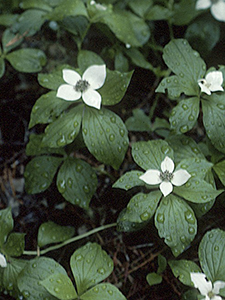
In 1960 Ken Avery experimented with planting Bunchberry Dogwood (Cornus canadensis). He considered the species to be a successful introduction and ordered a large number for planting in 1962. Martha Crone had first planted this species in 1933 and ‘34 and it was still on her 1951 plant census. It was indigenous to the Garden and Eloise Butler planted it many times, but it is no longer extant.
In the Friend's Newsletter, (Vol. 9 No. 4) editor Martha Crone wrote on the Hermit Thrush and of the Maidenhair Tree (Ginkgo biloba), which tree she had planted in the Garden in 1948; also of herb gardens and the common tomato. She considers autumn with these words:
Autumn’s smoldering blaze of brilliance after summer’s green has vanished is most noticeable where birches flaunt a trim of gold, mingled with the flaming scarlet of maple and bronzes of the oaks.” and quotes Ralph Waldo Emerson - “The beauty that shimmers in the yellow afternoon of October, who could clutch it? Go forth to find it, and it is gone.
Sigurd Olson’s “A Need for Wilderness” wass discussed.
Then there was an extensive section on the completion of the Fern Glen.
[Note: In 1955 the Friends received a gift of funds from the Minnetonka Garden Club and the Little Minnetonka Garden Flower Club which Martha used to create a fern glen in an undeveloped part of the Garden. She began planting in 1956 by setting out 2,160 fern plants followed by 308 the next year and completing the project in 1958 when the total reached 2,844 fern plants. Ken Avery added an additional 250 plants in 1960 bring the total planted to 3,094 before any losses]
Plants were arranged on the hilly area with Ostrich Fern, Cinnamon Fern and Royal Fern at the base where it is moist. Brittle Bladder and Bulblet Bladder were on a slope under an Oak. Lady Fern and Interrupted Ferns were on the steepest part, exposed to sun. In other spots were placed - Christmas Fern, Goldie’s fern, Hayscented fern, Narrow-leaved fern, Spleenwort, Silvery Spleenwort, Marginal Shield Fern, Spinulose shield Fern, Crested Wood Fern, Narrow Beech Fern, Bracken Fern and Rattlesnake Fern (Virginia Grape). [Thumbnail sheet of all these ferns.]
Below: The upland as it looked in the Spring of 1961. The loop path toward the upper right approaching the back fence where the new Fern Glen was being developed in the NE corner was removed in later years. A new path through the Glen was made and is barely visible in the photo. The Odell memorial bench of 1959 is in place but still no visible path to the lone oak. The Nordquist fountain will not show up until 1995. The little triangular area with branching side path noted in photo was removed in later years as was the long path paralleling the fence line. Photo courtesy University of Minnesota.
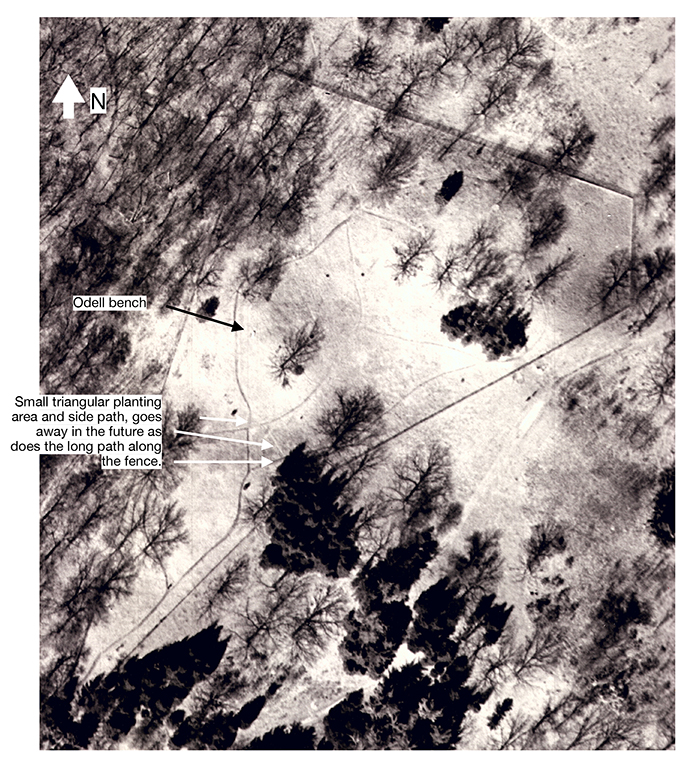
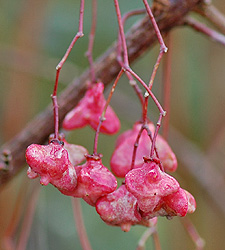
Martha Crone's final article in this issue was about Wahoo (Euonymus atropurpureus) and how after the foliage dries, the red seed capsules are displayed, each seed coated with the red of the Cardinal Flower - a color used on no other fruit or flower [in the eastern half of the United States]. These capsules are the size of burst popcorn and in the shape of 4-cornered hats, appearing in masses.
Fall temperatures were warm in October with a moderate amount of rainfall followed by heavy snow in December with December average snow depth around 8 inches, entirely unlike the previous winter when there was scant snow. Ken Avery stated in his annual report (1) that:
The Garden went into winter in good condition with plenty of moisture in the soil and we have excellent cover this winter. This snow that makes our lives so miserable is a gift from the gods to the plants and I expect the best spring bloom in years.
The Garden’s Purpose:
Some of Ken’s other statements in his annual report are worth noting. He stated that approximately 100,000 people visited the Garden in 1961 and he said this to emphasize that the Garden is being used to near capacity.
On a busy Sunday the cars do not only fill our parking lot and the parking area at the spring, but also fill the parking area by Birch Pond and even line the road to the main Parkway.

Then he gives a bit of his philosophy which still holds true today:
Actually the number of people using the Garden is not nearly as important as the type of use the Garden receives. In the spring and fall teachers from schools from all parts of the state visit the Garden with classes from kindergarten through college. In the hours between school and closing, groups of Girl Scouts, Boy Scouts, etc., make use of the Garden for their nature study. The garden clubs that visit the other gardens visit us too, but our educational service is unique among the gardens. We also provide one of the few places where someone who does not have a car can find some of the forest birds, or for that matter find a little peace and quiet.
One final bit on new infrastructure was added to the Garden in 1961. The restroom facilities at the Garden had always been, as Ken Avery put it, "the hole in the ground variety." This was replaced by chemical toilets which "I think it is a significant improvement." (1).
It would not be until 1973 when the existing structure was built with help from the Friends funding of materials to house the facility.
At year end, Friends membership totaled 165. One noted member who had passed away was Gertrude Cram. (2)
Notes:
(1). Annual Report of the Garden Curator to the Board of Park Commissioners dated March 5, 1962, to Superintendent Howard Moore.
(2). Friends of the Wild Flower Garden Secretary’s Report - 1961
Photo top of page: Entrance to the Fern Glen in 2012. Photo ©G D Bebeau
Printable PDF file of this page.
Links to related pages:
- Abbreviated Life of Eloise Butler
- Martha Crone - 2nd Garden Curator
- Ken Avery - 3rd Curator and Gardener
- Cary George - 4th Gardener
- Our Native Plant Reserve - Short document on the origins of the Garden.
- Eloise Butler's writings, a selection of essays written by Eloise Butler on the early Garden years.
- Geography of the Garden- an illustrated tour
References:
Martha Crone's Garden Log and her 1951 Census of plants in the Garden.
Various papers and correspondence of Eloise Butler and Martha Crone in the collection of the Minnesota Historical Society.
Photos by Martha Crone are from her collection of Kodachromes that was given to the Friends by her daughter Janet following Martha's death in 1989.
Meeting Minutes and correspondence of Friends of the Wildflower Garden.
Archive of the Friends Newsletter The Fringed Gentian™
Vol. 9, # 1, January 1961, Martha Crone, Editor.
Vol. 9, # 2, April 1961, Martha Crone, Editor.
Vol. 9, # 3, July 1961, Martha Crone, Editor.
Vol. 9, # 4, October 1961, Martha Crone, Editor.
Historical Climatology of Minneapolis-St. Paul Area by Charles Fisk.